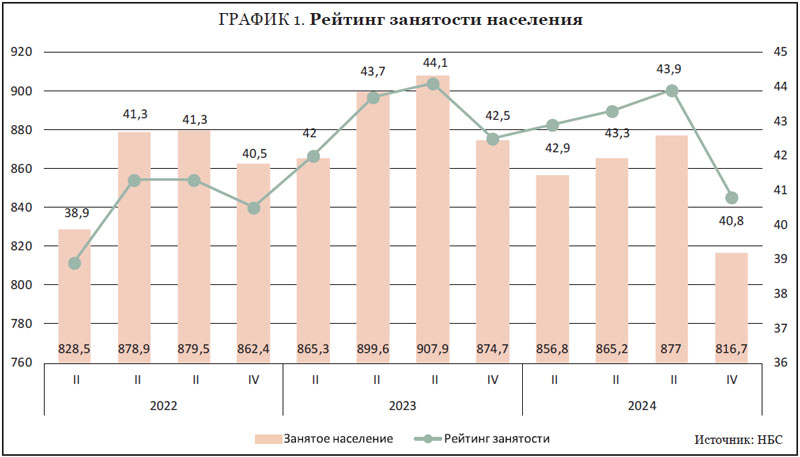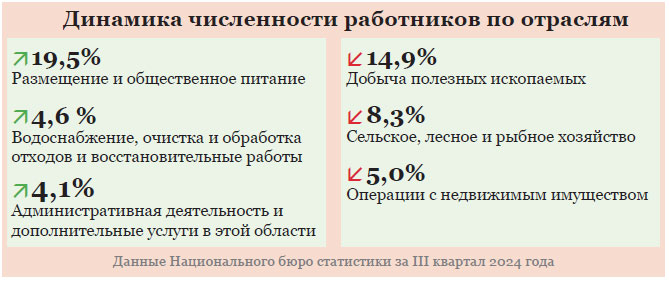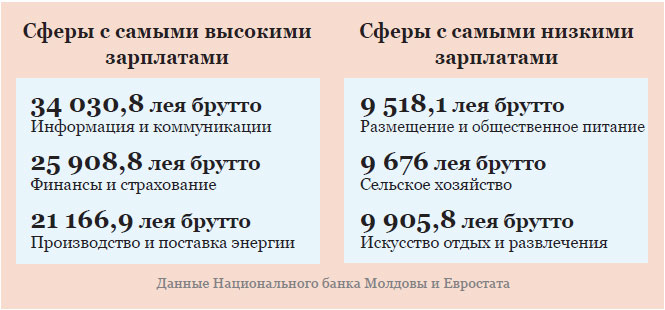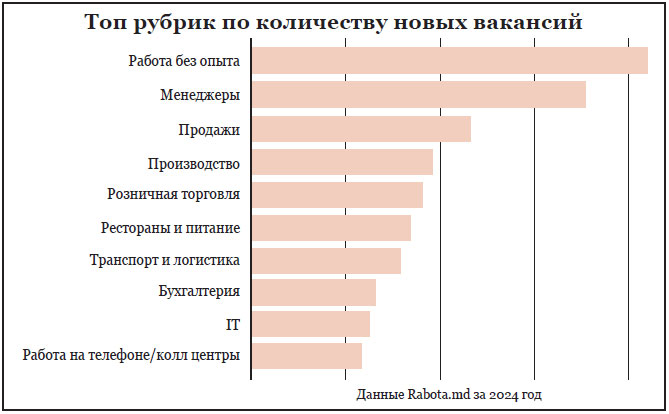
Annualized employment trends (with seasonal fluctuations in activity) show an overall negative trend, declining from 856,800 people employed in the national economy in Q1 to 817,000 in Q4 2024 (see Graph 1).
Territorially, the largest decline is in the Center region (minus 26 thousand people, or 12%). The employed population in the North and South regions decreased by 18 thousand people each. In the capital, on the contrary, the number of employed people increased by 4 thousand people.

The average age of the working population amounted to 44 years. By the end of the year, the employment rate (the share of the employed in the total population aged 15 and over) fell to 40.8% (-1.7 p.p.). Men have a higher employment rate (43.2%) than women (38.8%). Almost half of the able-bodied population work in cities (49.4%), while in villages about a third (34.5%). Decrease in the employment rate is observed in all age categories, especially among young people.
The number of employed people in Q4 2024 is its lowest level in at least the last 15 years, economists have calculated. In general, compared to 2015, the number of employed people decreased by 145 thousand people or 15%. Employment decreased primarily in industry and agriculture.
The average number of employees is still stable, and even slightly increased, judging by the data of statistical reports of enterprises. However, as Natalia Kleinknecht, Head of the Department of Labor Market Statistics, explained, the sample of enterprises, although representative, especially large ones, does not cover the whole range of employment. Only the labor force questionnaire survey gives a complete picture.
 The resource potential of the labor force (economic activity) is also decreasing. Participation of the population (employment plus readiness to look for, change profession and find a job) makes 42.5% in the analyzed period, having decreased by 2.2 p.p. People aged 20-64 (57%) are more active on the labor market. Unemployment remains at a low level, but the growth of wages is only slightly ahead of inflation. At the same time, the variation of labor costs by industry is significant. According to economic expert Veaceslav Ionita, only about 16% of those employed in the national economy earn more than 20,000 lei per month.
The resource potential of the labor force (economic activity) is also decreasing. Participation of the population (employment plus readiness to look for, change profession and find a job) makes 42.5% in the analyzed period, having decreased by 2.2 p.p. People aged 20-64 (57%) are more active on the labor market. Unemployment remains at a low level, but the growth of wages is only slightly ahead of inflation. At the same time, the variation of labor costs by industry is significant. According to economic expert Veaceslav Ionita, only about 16% of those employed in the national economy earn more than 20,000 lei per month.
The “niche” nature of labor remuneration inherent in the economy is a reflection of the differentiated demand for scarce highly qualified personnel, on the one hand, and workers without special skills, on the other. “The outflow and aging of the population, as well as the shrinking talent pool, are the new reality in Moldova. Employers must be prepared for the fact that competition for specialists will continue to grow. Therefore, the strategic priority of companies will be to retain and attract personnel, including from abroad.” This is the conclusion of a specialized recruitment website.
According to the observations of aggregators, including governmental ones, last year the number of new job offers decreased, and job seekers, although becoming more active, approach the job search with caution, trying not to lose their previous jobs. Figures indicate that it is employers who dictate the terms – but this advantage is temporary. The key challenge is demographics. The capital remains the absolute leader in the number of vacancies: 68.8% of all offers are concentrated there. Regions account for 26.7% of vacancies, and work outside Moldova accounts for 4.5% of vacancies.
 “Employers in small localities often do not use the services of job platforms because they either do not know about them or do not believe in their effectiveness. They prefer traditional methods such as word of mouth and posting in local communities on social media. However, the demand for workers in the regions continues to grow, which creates prerequisites for change,” says Rabota.md’s manager for working with employers Vladimir Badan.
“Employers in small localities often do not use the services of job platforms because they either do not know about them or do not believe in their effectiveness. They prefer traditional methods such as word of mouth and posting in local communities on social media. However, the demand for workers in the regions continues to grow, which creates prerequisites for change,” says Rabota.md’s manager for working with employers Vladimir Badan.
If we talk about regional vacancies in the public sector, city halls and local institutions are usually published on the state platform, but sites that specify the approximate level of salaries and flexible requirements of the employer have more success. Including those related to the possibility of remote work and flexible working hours.
The most popular job search queries relate to jobs as a driver, accountant and waiter. There has also been an increase in interest in vacancies for designers (in IT and other areas), logisticians, marketers, technologists and cleaners. In addition, users of recruitment platforms were actively looking for part-time and remote work. But the preferences of job seekers most often do not match the conditions offered. The share of vacancies for remote work, according to observations, is minuscule, with hybrid mode of work – even less.
Employers increasingly evaluate candidates not on the basis of their education, but on their skills and ability to solve applied tasks. Most vacancies do not contain strict requirements to the level of education and work experience of candidates. Of the rest, in most cases higher education is preferred, in the rest – secondary vocational education.
Regional preferences of candidates mostly coincide with the employers’ offer. The absolute majority of applicants want to work in Chisinau municipality. Bălţi, Comrat, Orhei and Cahul are also among the top five localities popular with job seekers.

According to the experts of recruitment platforms, in order to remain attractive, employers will have to not only adapt their salary offers, but also go against the global trend by introducing flexible forms of work that are in demand by employees – this would allow them to close some vacancies at the expense of Moldovans from remote settlements and foreigners without the need to relocate them.
It will remain a challenge for businesses in the regions to use modern recruitment tools. Besides, the need for foreign workers will remain relevant. And it will continue to grow both in highly qualified positions and in blue-collar positions.
Despite the staff hunger, experts advise candidates, especially young specialists, to be ready for tougher competition even in low-skilled positions. Although employers are open to hiring candidates without experience, the key remains the development of applied and personal skills.













